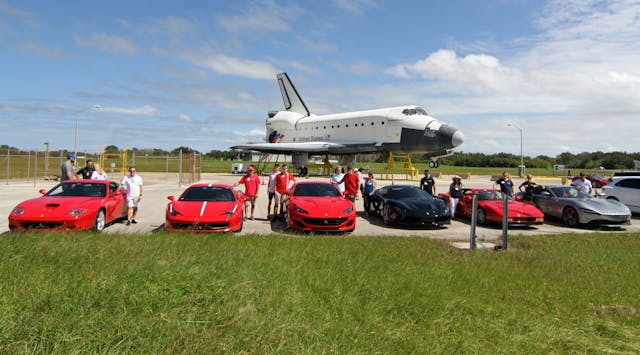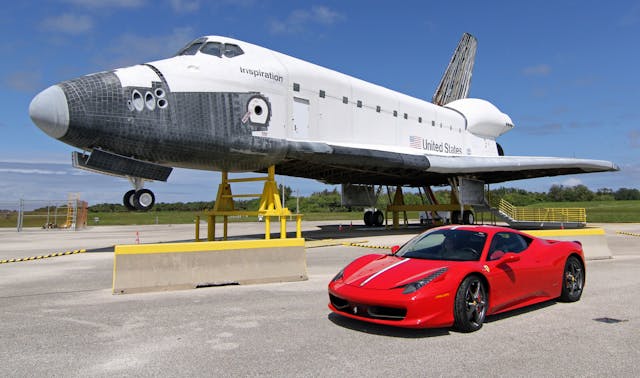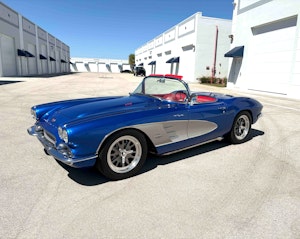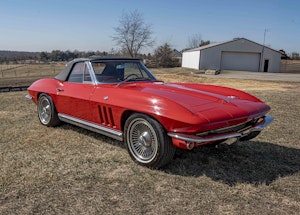Media | Articles
Starfighters meet Ferraris at Kennedy Space Center
If you happened to be at Kennedy Space Center one day last month, you perhaps saw a gorgeous parade of Ferraris heading past the enormous hangar that held the Artemis 1 rocket. What was a fleet of Maranello’s finest doing at NASA’s launch center on Florida’s Merritt Island? They were en route to an event sponsored by Hagerty, so we were allowed to tag along for a once-in-a-lifetime tour. Curious? Read on.
The Ferrari owners were members of the Greater Orlando Chapter of the Ferrari Club of America, and the event is one of 10 or 15 the club will hold this year celebrating the 60th anniversary of the marque. The trip, which required us to obtain a security clearance, was organized by chapter President Arun Reddy.

It turns out one of Reddy’s close friends is Rick Svetkoff, president and CEO of a company called Starfighters. He is a former U.S. Navy pilot, flying the A-4 Skyhawk. After leaving the Navy, Rick served as a captain at Continental Airlines, where he flew the B727, MD80, B757, and B767.
Shortly after starting with Continental, Rick purchased an F-104 ex-military jet and began flying at air shows. He then acquired a fleet of the jets for a three-aircraft Starfighters Demonstration team. Ultimately, he envisioned this F-104 fleet as the core asset of a small, fast-reacting aerospace company for a wide range of missions.

Moving beyond air show operations, Rick was invited by NASA to establish Kennedy Space Center as Starfighters’ base of operations, to support the center’s growth as a commercial spaceport. Svetkoff has accumulated a small fleet of Starfighters, otherwise known as the F-104 fighter jet, to which he has essentially dedicated his life. He has big plans for his planes, which we’ll detail here in a moment, but presently he offers a limited number of rides for paying customers, as well as training. This is, by the way, the world’s only fleet of flight-ready F-104 supersonic aircraft.
Marketplace
Buy and sell classics with confidence
“Rick is one of the best people I know,” the Ferrari club’s Reddy said. “He’s devoted decades of his life to this project. Once he got his license for civilian use, unfortunately it’s just a certain demographic that can afford a ride in an F-104. I told him it would be a win-win if you could open up your hanger to our members, and you can offer your services to us. And that should get them going.” Thirty members submitted RSVPs for this event, and since Ferrari owners are typically well-heeled and interested in speed, it seems like there’s a good chance a few might return for a ride. You must be a licensed pilot at least holding a private pilot’s certificate to fly a Starfighter.

Svetkoff is a fascinating fellow. “I started the organization in 1995,” he told us. “We were able to purchase our first aircraft, which is now in a museum.” The next F-104 came a year later, and that plane is now being parted out “to support our other aircraft.” He started performing at airshows in 1996, which the Starfighters now rarely do. In 2009, he retired from the airlines, “and came over here to do this full-time.” By 2011 he had four F-104s, “and it took us about three years to get them operational.” He hopes to have a fifth plane in the air by next May.
The Lockheed F-104 Starfighter first flew in a test in March of 1954 and began production four years later. It first served with the U.S. Air Force, performing over 5,000 combat missions in Vietnam. The F-104 had a rather short lifespan with the U.S. military, but it eventually flew with 15 different air forces of various nations, from Pakistan to Turkey to Italy, which was the last to retire the plane from active duty, in October of 2004. It was the first production jet to hit Mach 2, and the first to fly to 100,000 feet under its own power. (Mach 2, by the way, is twice the speed of sound, or 1522 mph.)
The Starfighter served with NASA from 1956 until 1994, performing high-speed and altitude flight research at Dryden Flight Research Center. The F-104 also performed many safety chase missions in support of advanced research aircraft, and provided a launch platform for research rockets.
In all, 2578 were built, and as mentioned, only a handful remain. During its overseas service, the plane’s reputation suffered: The Germans lost 292 of 916 F-104s, and 116 pilots from 1961 to 1989, its high accident rate earning it the nickname “the Widowmaker.” They were supposedly difficult to fly, and the single General Electric J79 engine could be finicky.

All not necessarily true, said Svetkoff. He has never lost an F-104. Proper maintenance and training is the key. From his unassuming start as an airshow performer, Svetkoff has created a formidable business in the “commercial space market,” he said. One of the near-term goals: Launching multiple nanosats—a miniaturized satellite that, with some “micro” versions, you can hold in your hand—into low orbit, without the expense of using a rocket. He’d be flying the F-104 at Mach 2, and probably 35,000 feet to launch the nanosats, aiming upwards at probably a 15- or 20-degree angle. He’ll use 3-D modeling to figure it all out.
Riding in an F-104, Svetkoff said, would also be good training for civilians who are paying their way on to the available commercial sub-orbital rockets. “We were ahead of our time,” he said.
After the tour of his hangar—it once held the reconstructed remains of the space shuttle Columbia, which, he said, you can sometimes see the outline of on the floor when the light is right—one of the Starfighters pilots taxied out on the huge runway that the shuttles once landed on. The takeoff was breathtaking, as was a fly-by in which the F-104 was levered upwards in a near-90-degree angle, disappearing into the sky as it headed out over the Atlantic Ocean.
In all, it was a heck of a Ferrari Club outing. You can read more about the Starfighters at Starfighters.net, and the Ferrari club at fca-orl.org.














